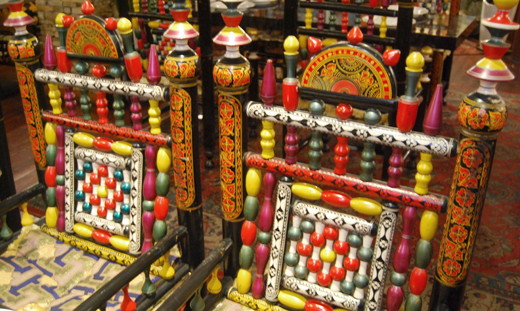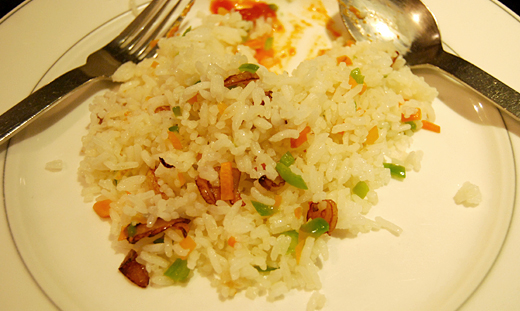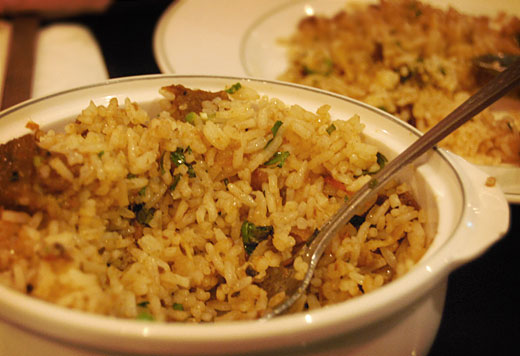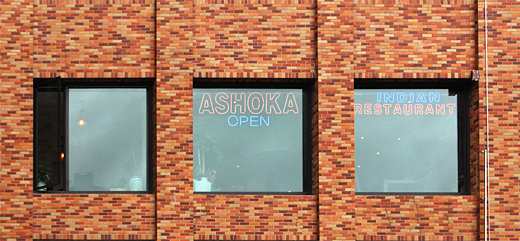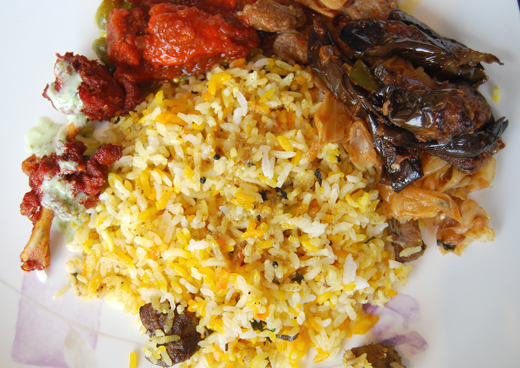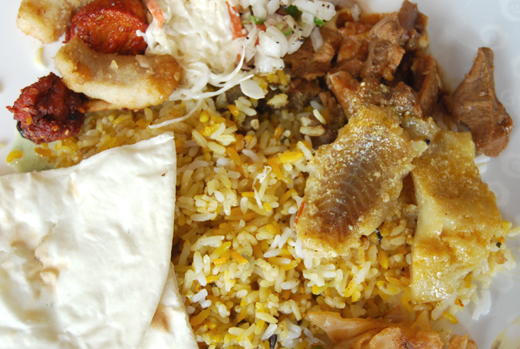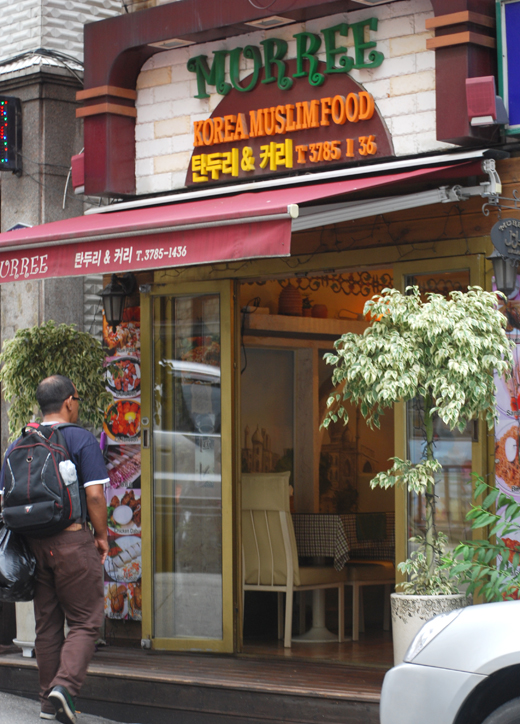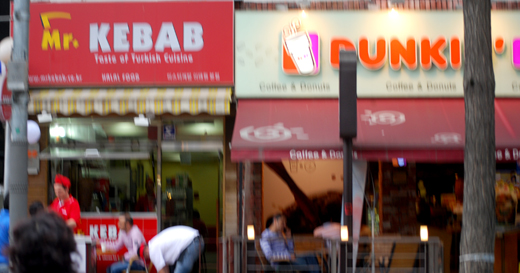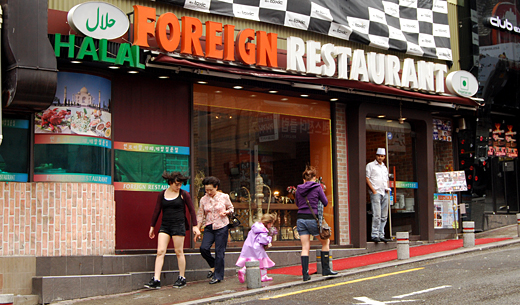Seoul, SK
-
Art & Places: Jangseung, South Korea
When my husband and I visited Korean Folk Village on our last day in South Korea, these totem poles greeted us. Lucky for me, I visited National Folk Museum of Korea a day before that and knew that it is called Jangseung.

Jangseung totem poles, Korean Folk Village.
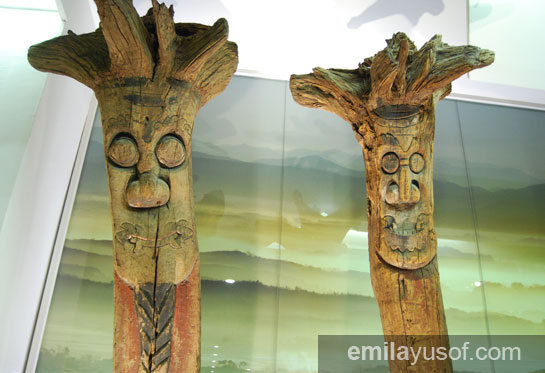
Couple Jangseung looking down at me. National Folk Museum of Korea.
Jangseung is regarded as one of the earliest examples of non-figurative art, in which a human face is carved on a wooden pole (tree trunk). Jangseung has the face of traditional Korean military officer with angry eyes, snaggle teeth and a hat on top of the pole with an inscription down at the middle. The inscription bears the meaning of ‘Great General Under Heaven’ for males, and females ‘Female General Under Earth’. These wooden totem poles, erected in groups or pairs at the entrance of Buddhist temples or villages, were worshipped as village guardians or deities with magical powers that drive out demons. Jangseung is also indicated as the border between neighbouring villages.
The history of Jangseung is dated back more than 2000 years ago. Once considered a deity, it is mostly a decorative piece now and commonly placed at the gates of large places to indicate entrances.
Jangseung is considered an organic work of art and is generally expected to last about a hundred years due to nature’s harsh elements.
I found one interesting blog post about Jangseung by Nick Elwood in his blog: A Korean Compendium. His blog post: Fascinating Physogs – A Tour of Some Korean Totem Poles explores the many types of Jangseung. Go read it.
-
Art & Places: Korean Dancheong Art
During my visit to the Gyeongbokgung Palace, I noticed that every building has a very attractive and vibrant paintings.
Curious of finding more about the art, I took pictures for the purpose of studying the design and went Yahoo-ing the net. I didn’t know what the name of the style was, but I just typed in “culture of Korea” and voila! I found a wiki page about the art. It is called Dancheong.
Dancheong is a multi-coloured decorative painting mostly done on wooden buildings and artifacts for the purpose of style and to protect surfaces and conceal the crudeness of materials.
Originally arriving with Buddhism when it was brought from China, the patterns of Dancheong were modified in Korea. It is said that during the Shilla period, Dancheong was even found on commoners’ home. Now it is limited to temples and palaces as well as some musical instruments.
Dancheong is based on five basic colors; blue (east), white (west), red (south), black (north), and yellow (centre).
According to its design, colour and style, Dancheong is classified into five types: Gachil Dancheong, Geutgi Dancheong, Moru Dancheong, Geummoru Dancheong and Geum Dancheong.
There are also special kinds of Dancheong such as Gobun Dancheong, Chilbo Dancheong, Geumbak (Eunbak) Dancheong, Geumni (Eunni) Dancheong and Ottchil Dancheong.
Gachil Dancheong usually uses a green or reddish-brown monochromatic under-painting with no patterns. Geutgi Dancheong adds some decorative patterns by drawing black and white lines on a single-colored under-painting. Moru Dancheong draws a simple-shaped Meoricho (pattern) only on the ends of the bracket, and adds the finishing touches to the middle part of the bracket with black and white lines. Geummoru Dancheong is a crossover of Moru Dancheong and Geum Dancheong, adding some geometric patterns to Moru Dancheong. Geum Dancheong boasts the most colorful paintwork, with various kinds of elaborate silk patterns and Byeoljihwa (decorative pictures) drawn on the whole part of the bracket, except the part on which Meoricho is drawn.
The process of Dancheong is as follows: at first, workers begin to work with polishing the foundation of Dancheong. After applying boiled water including glue to the foundation, they prepare the drafting paper by coating it 5 times.
In order to put figures of drafting paper on a building, they must spread blue & green soil on it. When they tap a powder bag on framework-covered surface, it flows out from a hole and outlines the figures carved in the frame. After, they decorate the building with paint using the basic five colours.
Overall, I really love this one unique aspect of Korea. To me, art truly reflects the culture values of a country and I am glad that I had the chance to experience and see this art form myself.
Here’s my take on Dancheong on watercolor paper with my color preferences. It doesn’t have specific meaning as I was just exploring the design.
-
Seoul, the soul of Asia
Remember my trip to Seoul, South Korea in June 2011? Here’s the complete article about my visit there. I hope it can be a guide or some kind of reference for you to read prior to your visit there. Pardon me for the heavy loads of images.
It was great visiting Seoul. I wish I could extend my stay and truly feel the soulfulness.
Arriving at the airport, my husband and I were greeted by the rain. I just love rain, the fresh smell it brings out. This is true you know, not just to comfort myself for not traveling during the spring.
Really.
Ok, that was partly to comfort myself. The smell of the rain part is purely true, I did not make that up. Try go running or dancing or walking in the rain, you’ll understand what I’m talking about.

You see, we were dying to travel to Seoul in the Spring (earlier June) but due to some circumstances, we had to travel at the end of June. And that was during the rainy season. We could not travel on any other months as we were bound by MAS’ terms and condition.
The rainy season or Jangma as the local people call it, lasts from the end of June till the end of July, for about 30 days. The taxi driver told me this but according to other sources, sometimes it will rain until the end of September. Come rain or shine, the locals seem to enjoy the season. I enjoyed watching them walking in rain with style.

And boy, the wind was quite heavy that it almost blew me away. It turned my umbrella inside out.

Nonetheless, the rain did not stopped me from discovering Seoul. I visited Namsan Park, Itaewon, Namdaemun Market, Gyeongbokgung Palace, Korean Folk Museum and Korean Folk Village.
Our second day in Seoul was quite productive. We went to Itaewon and Namsan Park.
Itaewon is a city district, in Yongsan-gu, Seoul and it is a popular area for residents of Seoul, tourists, and U.S. Military personnel. Many restaurants serving international dishes are found in this area including cuisine from India, Pakistan, Egypt, Turkey, Thailand, and Mexico, foods that are not widely available in Korea. The Seoul Central Mosque is also located in Itaewon.
Local landmark Hamilton Hotel can be found here as well as dozens of shops and services aimed at tourists. High quality leather products in Korea can be found here at reasonable prices as well as various types of traditional Korean souvenirs.


And the visit to Namsan Park was great! I get to capture flowers in the form of photo as well as drawings.



Namsan Park is one of Seoul City’s largest green spaces and is the first Botanical Garden of Korea. It is a home to a numbers of species, which include foliage, fleshy plants, cactus, dwarfed potted plants, and orchids.
There are also exercising spots and walking trails and many Seoulites come here for their daily walk. From up here we can capture panoramic view of the city of Seoul.
If you are in Seoul, do drop by Namsan Park. Attractions include the Seoul Tower, National Theater, Namsan Public Library, and statues in memory of Korean patriots, etc.
Namsan Park is facilitated with a cable car that leads to the Seoul Tower. A tour in Namsan Park is completely free, except for the cable car ride for which a ticket has to be purchased. I did not get on the cable car as it was closed due to strong winds however there is a bus number 02 at the bottom of the park to take you up to Seoul Tower.


Visiting the Gyeongbokgung Palace, Korean Folk Museum and Korean Folk Village was more like it. I got to learn about Korean culture and traditions.
Gyeongbokgung Palace
Gyeongbokgung Palace is a symbol of majesty for both the Korean nation and the Korean royal family. Gyeongbokgung Palace or Palace of Shining Happiness was originally constructed in 1394 by King Taejo, the first king and founder of the Joseon Dynasty. But the majority of the palace was burnt down during the Japanese invasions of Korea between 1592 and 1598. Palace buildings that survived the Japanese occupation and Korean War include Geunjeongjeon the Imperial Throne Hall, Hyangwonjeong Pavilion, Jagyeongjeon Hall, Jibokjae Hall, Sajeongjeon Hall, Sujeongjeon Hall, and Gyeonghoeru Pavilion.
Amongst buildings that I explored were: Geunjeongjeon (The Throne Hall), Gangnyeongjeon (The King’s Quarters), Gyotaejeon (The Queen’s Quarters), Jagyeongjeon (The Late Queen’s Quarters), Gyeonghoeru (The Royal Banquet Hall) and Hyangwonjeong (small, two-story hexagonal pavilion).
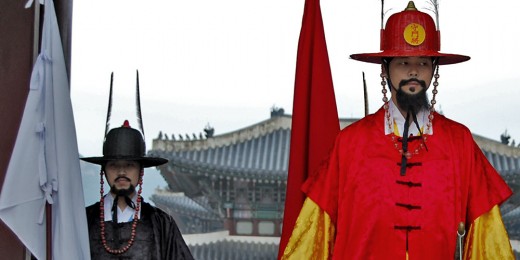
Officials at the Gate

The main Gate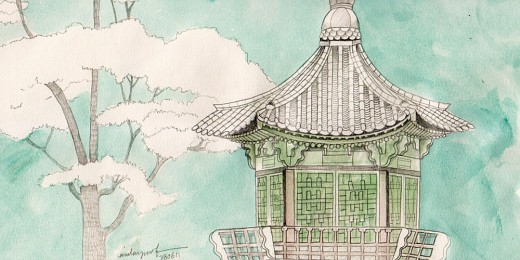
Hyangwonjeong
After visiting the palace, I visited the Korean Folk Museum.
Korean Folk Museum
This museum is located in the palace area, so if you visit the place, do drop by the museum.
The museum uses replicas of historical objects to illustrate the folk history of the Korean people. The museum has three exhibition halls which illustrate ‘The History of the Korean People’ from pre-historic times to the end of the Joseon Dynasty in 1910, ‘The Lifestyle of the Korean People’, and ‘The Lifecycle of a Korean from Birth to Death’. It also houses a children’s museum and an outdoor exhibition.
The museum was originally sited on Mt Namsan, and moved to Gyeongbokgung in 1975. The current building was built in 1972 and housed the National Museum of Korea until 1986. It was remodelled, and reopened as the National Folk Museum in 1993. The building’s design is based on various historical buildings around South Korea.
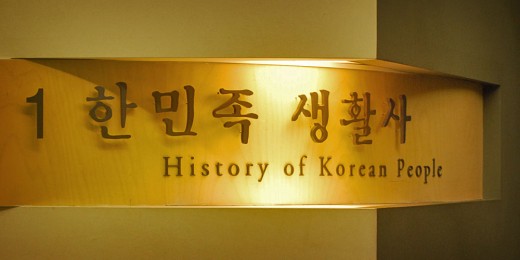
Entrance to the main hall

Folk paintingHere’s a slideshow and video to sum the visit to both place:
Korean Folk Village
The Korean Folk Village has over 260 traditional houses set in a natural environment occupying approximately 243 acres of land. Houses in the folk village not only include typical houses of commoners, farmers, and noblemen from the southern, central, and northern parts of Korea including island areas, but also buildings for special purposes, such as the shrine of scholars, the provincial governor?s office, a private school, a Buddhist temple, and shaman’s house.
Many of the buildings and houses were relocated to the folk village and restored according to the original lifestyle of the Korean people in the late Chosun period. Approximately 30,000 items of daily life have been collected from diverse regions and placed in each room based on their characteristics and period.
Various traditional lifestyles are also reproduced in the exhibit houses and crafts workshops for tourists to experience the culture of traditional Korean life: crafts include bamboo weaving, yarn spinning (out of cocoons!), silk making and many more. Crops like rice, barley, wheat, cotton, ginseng, sweet potato, radish, and sesame are cultivated in a traditional way so that visitors can observe the whole process from seeding to harvesting.

The main entrance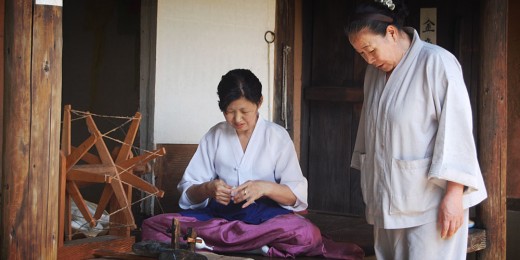
Silk making
Here are more picture from the village:
Namdaemun Market
If you need to go shopping in Seoul, consider visiting Namdaemun Market.

Namdaemun Market is one of the oldest continually running markets in South Korea, and one of the largest retail markets in Seoul that covers over 10 acres. It is filled with over 10,000 shops, stalls, retailers, street vendors, and has several department stores nearby. Here you can find clothes, shoes, fabrics, tableware, flowers, vegetables, ginseng products, toys, and watches. Newly designed Hanboks (traditional Korean costume), blankets, and bed sheets can be purchased at great bargains. You can get a t-shirt here for the price of 2000 won instead of buying elsewhere with the price of 7000 won. Cheap, right? I was a bit frustrated as I already bought few t-shirts at Itaewon for the price of 7000 won each.
Namdaemun Market opens from 11:00pm to 3:00am, and is crowded with retailers from all over the country. It is closed every Sunday. Daily visitors here exceed 400,000 people.
Namdaemun Market first started under the reign of King Taejong (1367 – 1422, the third Joseon king) during the Joseon Dynasty (1392 – 1910), when the government built shops around Namdaemun and rented out the shops to traders. The market began to take its form as a trading marketplace during this era and continued to prosper until the Japanese took over management of the market in 1922 during the Japanese occupation. This went on for several years until the liberation of 1945 when the Koreans took control again, but the market continued to have a rocky history due to the onset of the Korean War and it was not until 1954 when the Seoul Namdaemun Market Co. Ltd. was founded that the market began to take hold again. In recent years, the market has undergone massive renovations and there are plans to renovate the market even more in the future.
To visit Namdaemun Market you need to take Seoul Subway Line 4 and exit at Hoehyeon Station (Exit 5).
-
Muslim Restaurants in Korea
Staying in a hotel that is quite near to the city center, getting Muslim food was not a problem at all. The most popular area that houses many Muslim food outlets is Itaewon. Itaewon is a popular tourists area. The Seoul Central Mosque is situated in Itaewon and therefore, there are many Muslim restaurants in the area.
Seoul Central Mosque, Itaewon.
I really love to try Korean vegetarian dishes but I couldn’t find any in the area. So don’t get me wrong saying bad things about me not trying Korean dishes. I did had a taste of kimchi but that was on the flight back to KUL. 😀
From the hotel to Itaewon, it took about 30 minutes train ride. My husband and I tried to walk from the hotel to Itaewon but that took us more than an hour to reach the place. That was probably because it was raining and the other valid reason was, we’re old couple here. We walk too slow.
1. Al-Saba Restaurant
The first restaurant we tried was Al-Saba. Al-Saba is a Pakistani Restaurant and the interior is beautiful. My husband loves the chairs and I simply love the beautiful Pakistani decorations.
pretty amazing chair, doncha think?
The restaurant specializes in lamb dishes, curry, and chicken dishes. We had garlic rice, Mutton Briyani, Chana Dhall and a set of samosa. As for drinks I had green tea and my husband, Alsaba Special Tea. It is a milk tea made from aranche flower and spread with bit of nuts. I had a sip and truly love the taste.
garlic rice
mutton briyani
Total we spent:
Mutton Briyani: KRW15,000
Garlic Rice: KRW7,000
Chana Dhall: 9,000
Special Tea: 6,000
Green Tea: 3,000
Samosa: 6,000
total KRW46,000 (RM129.00)The cost of living is quite high in Korea, so instead of converting everything to RM, we treated KRW10,000 as RM10.
If you want to visit Al-Saba, the address is: 34-50 Itaewon 1(il)-dong Yongsan-gu Seoul South Korea
2. Ashoka Restaurant
Next restaurant we visited was Ashoka Restaurant. This restaurant is part of the worldwide Islamic restaurant chain Ashoka. The first Indian restaurant to open in Korea. The address: 3rd Flr, Hamilton Hotel, Itaewon, Seoul.
We had buffet lunch for 23,000 per head that includes coffee. I had an extra drink which was lassi but when we pay the total was 46,000. Lassi is on the house, I guess.
3. Murree Restaurant
Third restaurant we tried was Murree. The restaurant specializes in Lamb Dishes, curry, and chicken dishes. The restaurant is very tiny but all the time crowded because the food is quite good. We again had Mutton Briyani, Chicken Briyani, 2 coffee and a take-away pizza. Total spent here was KRW23,000. Half of what we spent in Ashoka.
As for the address, I’m not too sure. But you’ll find this restaurant on your way to the mosque. From Itaewon-ro, take right up the hill and take left. Murree is on the right side of the road. Up a bit is the mosque.
4. Mr. Kebab
The next one we tried was Mr Kebab. I had Pilaf Chicken Kebab and my husband Mutton. We had coke and a juice. Total spent KRW 7,000. The address: 127-2, Itaewon-1-Dong, YongsanGu, Seoul. Just cross the road in front of Hamilton hotel and walk about 5 minutes.
sorry for the blurry photo, my hands were shaking, I was so hungry.
5. Foreign Restaurant
Last restaurant we tried was Foreign Restaurant. The menu is the same chicken and mutton and salad. We had coffee and tea. total spent was more or less was KRW25,000. The address is 136-45, Itaewon Dong,. Yongsangu, Seoul. It’s the first road you take on the way to the mosque after Itaewon-Ro. Situated On the left side of the road.
-
Gyeongbokgung Palace
The details are too magnificent to draw. So, so-so je lah.
Hyangwonjeong Pavilion.
While having a coffee break, I got to meet an uncle. I joined him sitting by the balcony of the cafe and draw. He painted on canvas, me just on my sketchbook.
Uncle and me.
My sketching of uncle.
Here are more photos from Gyeongbokgung Palace and National Folk Museum of Korea.
-
Seoul Tower drawing
-
Flower drawings
Finally, I am able to upload good pictures of my drawings using the scanner. Here are three drawings from Namsan Park. It was drawn live from the location.













